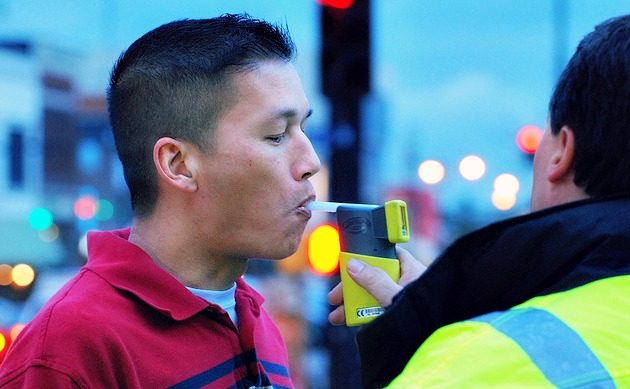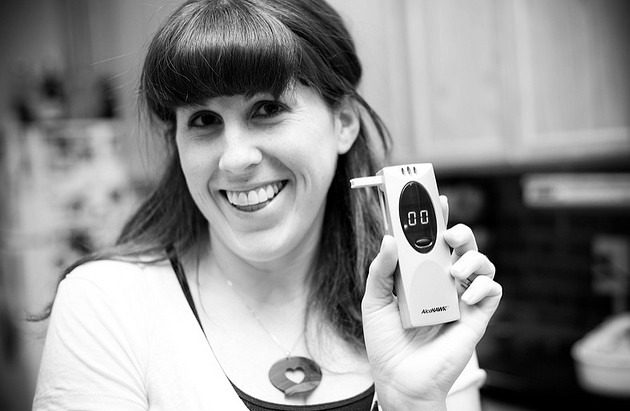Before you actually make a decision to provide a breath sample or refuse one, you should know what a breathalyzer is and what it does. In Montana, law enforcement use two different types of breath alcohol analyzing machines, or breathalyzers, if they suspect you of a DUI. In a police cruiser, law enforcement use a small, hand-held device commonly known as a Portable Breath Test, PBT, or Preliminary Alcohol Screening Test. The device looks like this:
So how does a breathalyzer work? A PBT device reads out a measurement of your breath’s deep lung alcohol concentration. Most people believe these machines are testing their blood alcohol, but in reality they are testing your breath alcohol.
The machine is designed to test a certain sample of air. Law enforcement is trained to have you blow through the disposable tube for several seconds, until you’re almost out of air in your lungs. The tube is hollow, so the breath blows through it.
However, there is a very small part of the tube that is an inlet into the PBT machine. When you have exhaled through the tube for several seconds, you’re beginning to exhale what is called deep lung air. This is believed to give a more accurate sample of what a true blood alcohol reading would be, as it is the alveoli air that is exchanging oxygen with the blood that is being exhaled. At that point, the officer depresses the “Set” button, which will allow the machine to capture a sample of that air running through the tube and be tested.
Let’s get technical for a second. PBT machines work on the science of a fuel cell. This type of fuel cell is an electrochemical sensor that reacts with alcohol. The reaction of alcohol with the fuel cell generates a number result that is shown on the display. Essentially, the more alcohol that reacts with the fuel cell, the higher the reading.
Source: KOMU News
Can a Breathalyzer Fail?
There are many factors that can cast doubt upon the breathalyzer’s reading. First, a breathalyzer must be constantly calibrated to ensure the fuel cell is reading correctly.
Law enforcement officers test breathalyzers by introducing a test gas with a known alcohol value so they know what the reading should be. If the PBT is not reading out the correct number of the test gas, it can be adjusted with a manual screw adjustment. The fact that this machine can be adjusted by hand and needs adjustment at times shows that fuel cells can degrade over time and become unreliable.
In addition, law enforcement must wait 15 minutes from when they first encounter a subject before obtaining a breath sample. This is because any residual alcohol in the mouth can affect the reading. For example, if you used mouthwash just before getting pulled over for a potential DUI and taking a breathalyzer test, the readout would be affected because mouthwash has alcohol in it. The industry standard seems to be a 15-minute wait to declare that any possible mouth alcohol would be gone and absorbed by the body prior to testing.
Breathalyzers at the Police Station
A breathalyzer at a police station is different from the one law enforcement officers have on the road. It’s a much larger and more advanced machine that also measures breath alcohol. Here’s what it looks like:
In Montana, most agencies use the Intoxilyzer 8000 manufactured by CMI Inc. This machine weighs almost 18 pounds and has a variety of improvements over the PBT. The Intoxilyzer 8000 analyzes alcohol using infrared spectroscopy, rather than the somewhat archaic fuel cell method of the PBT.
Without giving a science lesson, infrared spectroscopy is where infrared light passes through a sample of your breath. This breath is also deep lung air, just like with the PBT. Any alcohol molecules in your breath sample will actually absorb some of the radiation of the infrared light. The machine measures the amount of infrared radiation that hits the other side of the chamber against the amount that was started with, and the difference is a measurable amount of alcohol molecules that were present in the sample.
Don’t Try to Beat a Breathalyzer at the Station
The Intozilyzer 8000 is also more advanced than the PBT in that it allows the law enforcement operator to determine if the subject is actually blowing air into the machine. This breathalyzer tells the operator exactly when enough breath has been blown to obtain deep lung air, and the result is printed out on a paper, not just displayed on an LED display.
Often someone will try to “beat” a breathalyzer by blocking the machine’s straw with their tongue, or blowing air out between their cheeks and the straw. The Intoxilyzer 8000 actually has an audible buzzer that indicates when a proper breath sample is being blown into it. So if you’re trying to beat the machine, it will tell the operator what you are doing. The machine also determines when deep lung air is achieved and takes the sample itself, instead of the officer pressing a button, as with the PBT. Essentially, the Intoxilyzer 8000 takes the human error out of the equation and allows the breathalyzer to do almost everything.
So Should You Take a Breathalyzer Test?
In Montana, several cities including Missoula have enacted laws that make it a misdemeanor crime to refuse breath tests. Private criminal defense attorneys in Missoula, MT will typically tell you that if you drank more than 1 alcoholic beverage per hour, you are likely near or over .08, and you should refuse a breath test if pulled over for DUI.
Image: Janet Lackey
What advantages are there to providing a breath test or refusing a breath test? If you provide a breath test, there is really no advantage to you. If your breath alcohol is below .08, you can still be charged with a DUI. It is very rare for an officer to “unarrest” someone for DUI if they provide a breath sample below the limit. Often times, the officer thinks someone is also under the influence of drugs, and that combination is also illegal and falls under the DUI laws of Montana. In reality, there is no advantage to taking a breathalyzer test as far as prevailing in a DUI charge is concerned.
Refusing a Breathalyzer Test
The advantage in refusing a breathalyzer is simple: There’s less observable evidence against you, should you have a criminal jury trial to determine your guilt. I can tell you as a former prosecutor who has tried numerous DUI trials before jurors: Once a juror sees the breath alcohol concentration, and it is above .08, they just roll their eyes and wonder why they are even there. Then they convict you.
Breathalyzer results are simply too compelling of evidence to overcome at a trial. However, if there is no breathalyzer evidence in numerical form, prosecutors have a much more difficult time proving guilt beyond a reasonable doubt that a driver was under the influence. Prosecutors are stuck with evidence of field sobriety testing and a video of how the accused performed those tests. That evidence is much easier for a criminal defense attorney to argue before a jury and gives you a better chance for a not guilty verdict.
In the end, if you have honestly had less than 1 drink per hour, then you should consider taking a breathalyzer test, as you are not likely to be over the limit. However, 1 drink per hour is somewhat uncommon, and the average person that is drinking alcohol is drinking more than that amount. If you drink more than 1 drink per hour, your chances of being over the limit are too close to risk.
Have you ever taken a breath test? Have other questions? Leave them in the comments below and we’ll answer them, or contact one of our attorneys at the Judnich Law Office for a free consultation.

Marty is a former criminal prosecutor in the Cascade County Attorney’s Office and now uses that experience to defend those accused of crimes. A University of Montana School of Law graduate, Marty focuses his practice on personal injury and criminal defense and is a premier DUI defense attorney. He is also well versed in the insurance claims industry and has negotiated significant settlements with nearly every major insurance company.




